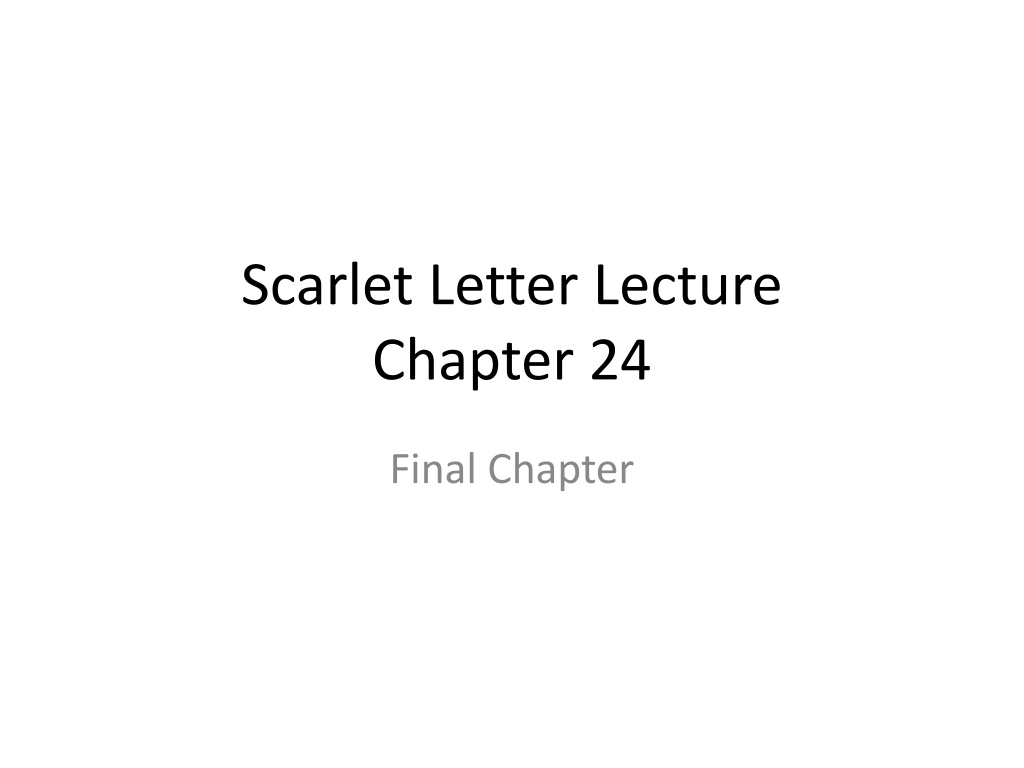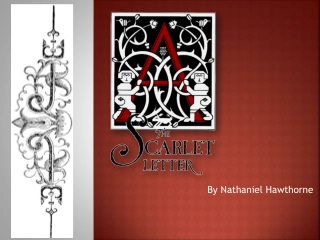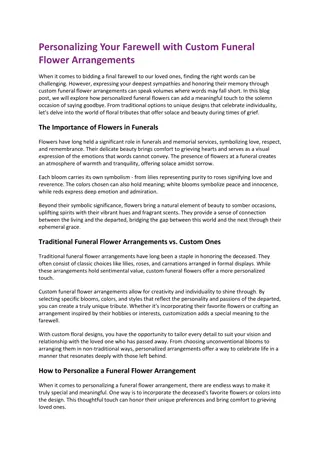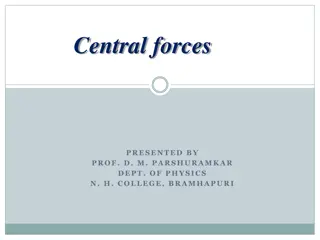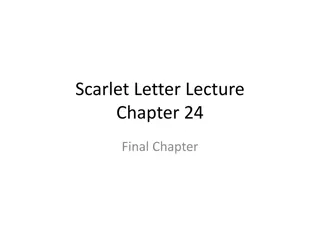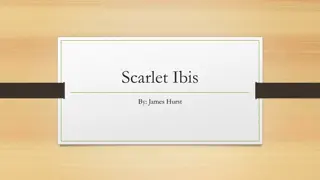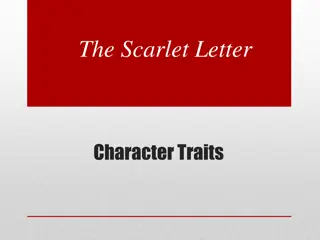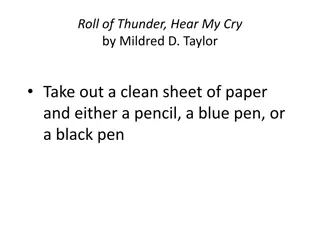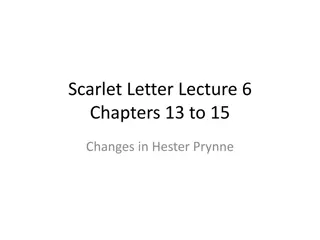Central Themes in "The Scarlet Letter" and "The Custom-House
The content discusses the central theme of concealment and exposure of truth, focusing on the sin of adultery in "The Scarlet Letter." It explores the relationship between Hester and Dimmesdale, the symbolic significance of the Scarlet Letter, the Scaffold, and the Forest. Additionally, it delves into the setting juxtaposition within the context of the persecuting Puritans in 17th century Boston, New England. The narrative unfolds with insights on the first-person narrator's ancestors and their Puritan traits, emphasizing the themes of human frailty and sorrow prevalent in the novel.
Download Presentation

Please find below an Image/Link to download the presentation.
The content on the website is provided AS IS for your information and personal use only. It may not be sold, licensed, or shared on other websites without obtaining consent from the author. Download presentation by click this link. If you encounter any issues during the download, it is possible that the publisher has removed the file from their server.
E N D
Presentation Transcript
Scarlet Letter Lecture Chapter 24 Final Chapter
Study and Revision Literature Paper 3 MYE 2015 Othello the Moor of Venice The Scarlet Letter: A Romance A Streetcar Named Desire Section B: Comparison of any two texts (1hr) Section C: Single Text Questions (1hr)
Central Theme Concealment and Exposure of the Truth concerning Sin the sin of Adultery Through the principal defining character relationship Hester and Dimmesdale; and the symbolic significance of the Scarlet Letter; the Scaffold; and the Forest; Setting (Juxtapositioning of different Settings) Set within the context of the persecuting character of the Puritans in 17thCentury Boston, New England
The Custom-House p12 First Person Narrator s Ancestors I seem to have a stronger claim to a residence here on account of this grave, bearded, sable- cloaked, and steeple-crowned progenitor who came so early, with his Bible and his sword, and trode the unworn street with such a stately port, and made so large a figure, as a man of war and peace a stronger claim than for myself, whose name is seldom heard and my face hardly known.
The Custom-House p12 and 13 Hard severity to a woman of their sect He was a soldier, legislator, judge; he was a ruler in the Church; he had all the Puritanic traits, both good and evil. He was likewise a bitter persecutor; as witness the Quakers, who have remembered him in their histories, and relate an incident of his hard severity towards a woman of their sect, which will last longer, it is to be feared, than any record of his better deeds, although these were many. His son, too, inherited the persecuting spirit, and made himself so conspicuous in the martyrdom of the witches, that their blood may fairly be said to have left a stain upon him. I know not whether these ancestors of mine bethought themselves to repent, and ask pardon of Heaven for their cruelties; or whether they are now groaning under the heavy consequences of them, in another state of being. At all events, I, the present writer, as their representative, hereby take shame upon myself for their sakes, and pray that any curse incurred by them as I have heard may now be removed.
Chapter 24 Given the nature of the plot of The Scarlet Letter and the progression of its plot development - Is a happy ending even possible? Recall the narrator s closing sentence in Chapter 1 - It may serve, let us hope, to symbolize some sweet moral blossom, that may be found along the track, or relieve the darkening close of a tale of human frailty and sorrow.
Chapter 24 Purpose of this Final Chapter? [It could be argued] that this final chapter serves three functions It speculates on what morals / moral lessons can be derived from the plot of this novel; Attempts to produce a happy ending for at least one of the characters; (Who?) And ties up loose ends of the plot;
Hesters Identity and Propensity Hester s identity is so interwoven with the place / setting of her sin that of Puritan Boston, New England; and also with the Scarlet Letter -A - that she returns to both; And eventually to be buried near, but not with her lover - Dimmesdale, Thus fulfilling the minister s declaration in Chapter 23 that theirs would always be an imperfect union.
Recall - Chapter 23 p222 The Law We Broke the Sin Shall we not meet again? whispered she, bending her face down close to his. Shall we not spend our immortal life together? Surely, surely we have ransomed one another, with all this woe! Thou lookest far into eternity, with those bright dying eyes! Then tell me what thou seest? Hush, Hester, hush! The law we broke! the sin here so awfully revealed! let these alone be thy thoughts! I fear! I fear! It may be, that, when we forgot our God when we violated our reverence each for the other s soul, it was thenceforth vain to hope that we could meet hereafter in an everlasting and pure reunion.
What did the Puritan spectators see imprinted on Dimmesdale s breast? Narrator presents multiple perspectives, rather than a single, definite viewpoint; Thus leaving it open to interpretation; Narrator then directs the Reader to decide on the interpretation that seems most reasonable p224; The subtext? What is most important at a fundamentally moral level - Be true! Be true! Be true! Show freely to the world
From Chapter 24 p223 Most of the spectators testified to having seen, on the breast of the unhappy minister, a SCARLET LETTER the very semblance of that worn by Hester Prynne imprinted in the flesh. As regarded its origin, there were various explanations, all of which must necessarily have been conjectural. Some affirmed that the Reverend Mr. Dimmesdale, on the very day when Hester Prynne first wore her ignominious badge, had begun a course of penance which he afterwards, in so many futile methods, followed out by inflicting a hideous torture on himself. Others contended that the stigma had not been produced until a long time subsequent, when old Roger Chillingworth, being a potent necromancer, had caused it to appear, through the agency of magic and poisonous drugs.
Chapter 24 p223 The reader may choose among these theories. Others, again, and those best able to appreciate the minister s peculiar sensibility, and the wonderful operation of his spirit upon the body whispered their belief, that the awful symbol was the effect of the ever active tooth of remorse, gnawing from the inmost heart outwardly, and at last manifesting Heaven s dreadful judgment by the visible presence of the letter. The reader may choose among these theories. We have thrown all the light we could acquire upon the portent, and would gladly, now that it has done its office, erase its deep print out of our own brain; where long meditation has fixed it in very undesirable distinctness.
p223-224 Reports of Spectators It is singular, nevertheless, that certain persons, who were spectators of the whole scene, and professed never once to have removed their eyes from the Reverend Mr. Dimmesdale, denied that there was any mark whatever on his breast, more than on a new-born infant s. Neither, by their report, had his dying words acknowledged, nor even remotely implied, any, the slightest connection, on his part, with the guilt for which Hester Prynne had so long worn the scarlet letter. According to these highly respectable witnesses, the minister, conscious that he was dying, conscious, also, that the reverence of the multitude placed him already among saints and angels, had desired, by yielding up his breath in the arms of that fallen woman, to express to the world how utterly nugatory is the choicest of man s own righteousness.
Chapter 24 p224 Note: POV This Version of Dimmesdale s Story [Narrator interjects and comments] - After exhausting life in his efforts for mankind s spiritual good, he had made the manner of his death a parable. Without disputing a truth so momentous, we must be allowed to consider this version of Mr. Dimmesdale s story as only an instance of that stubborn fidelity with which a man s friends and especially a clergyman s will sometimes uphold his character;
p224 Critically significant passage (Links back to The Custom-House) The authority which we have chiefly followed a manuscript of old date, drawn up from the verbal testimony of individuals, some of whom had known Hester Prynne, while others had heard the tale from contemporary witnesses fully confirms the view taken in the foregoing pages. Among many morals which press upon us from the poor minister s miserable experience; we put only this into a sentence: Be true! Be true! Be true! Show freely to the world, if not your worst, yet some trait whereby the worst may be inferred!
What of Chillingworth? Chillingworth, driven by revenge, (his obsession with revenge being rather similar to that of the lovers passion) Chillingworth is consumed by his own sin as Hester and Dimmesdale are consumed with their sin; However, Chillingworth partially redeems himself through his legacy Pearl;
Chapter 24 p225 Equivocation - Narrator reflects on Love and Hatred It is a curious subject of observation and inquiry, whether hatred and love be not the same thing at bottom. Each, in its utmost development, supposes a high degree of intimacy, and heart-knowledge; each renders one individual dependent for the food of his affections and spiritual life upon another; each leaves the passionate lover, or the no less passionate hater, forlorn and desolate by the withdrawal of his object. Philosophically considered, therefore, the two passions seem essentially the same, except that one happens to be seen in a celestial radiance, and the other in a dusky and lurid glow.
P225 Roger Chillingworth s - Last Will? Leaving this discussion apart, we have a matter of business to communicate to the reader. At old Roger Chillingworth s decease (which took place within a year), and by his last will and testament of which Governor Bellingham and the Reverend Mr. Wilson were executors, he bequeathed a very considerable amount of property, both here and in England, to little Pearl, the daughter of Hester Prynne.
What of Pearl? p225 So Pearl the elf-child, the demon offspring, as some people, up that epoch, persisted in considering her became the richest heiress of her day, in the New World. Not improbably, this circumstance wrought a very material change in the public estimation; and, had the mother and child remained here, little Pearl, at a marriageable period of life, might have mingled her wild blood with the lineage of the devoutest Puritan among them all.
Chapter 24 The Elf Child p226 But where was little Pearl? [Pearl disappeared along with Hester] p225-226 If still alive, she must now have been in the flush and bloom of early womanhood. None knew nor ever learned, with the fulness of perfect certainty whether the elf-child had gone thus untimely to a maiden grave; or whether her wild, rich nature had been softened and subdued, and made capable of a woman s gentle happiness.
What of the Scarlet Letter? P226 The Puritan Theme - Persecution For many years, though a vague a report would now and then find its way across the sea, like a shapeless piece of driftwood tost ashore, with the initials of a name upon it, yet no tidings of them unquestionably authentic were received. The story of the scarlet letter grew into legend. Its spell, however, was still potent, and kept the scaffold awful where the poor minister had died, and likewise the cottage by the sea-shore, where Hester Prynne had dwelt.
Chapter 24 p226 Hester? The cottage by the sea-shore Near this latter spot, one afternoon, some children were at play, when they beheld a tall woman, in a gray robe, approach the cottage door. In all those years it had never once been opened; but either she unlocked it, or the decaying wood and iron yielded to her hand, or she glided shadow-like through these impediments, and, at all events, went in.
Presentation of Hester p226 And Hester Prynne had returned, and taken up her long-forsaken shame. Through the remainder of Hester s life, there were indications that the recluse of the scarlet letter was the object of love and interest with some inhabitant of another land. Letters came, with armorial seals upon them, though of bearings unknown to English heraldry.
Presentation of Hester - Chapter 24 p227 *(Link back to The Custom-House) In fine, the gossips of that day believed, and *Mr. Surveyor Pue, who made investigations a century later, believed, and one of his recent successors in office, moreover, faithfully believes, that Pearl was not only alive, but married, and happy, and mindful of her mother; and that she would most joyfully have entertained that sad and lonely mother at her fireside. *[Refer to pages 30, 31, 32, and 33]
From The Custom-House p42 Now it was, that the lucubrations of my ancient predecessor, *Mr. Surveyor Pue, came into play. Rusty through long idleness, some little space was requisite before my intellectual machinery could be brought to work upon a tale, with an effect in any degree satisfactory. *[Refer to pages 30, 31, 32, and 33]
Presentation of Hester p227 Note Settings Juxtaposed But there was a more real life for Hester Prynne, here, in New England, than in that unknown region where Pearl had found a home. Here had been her sin; (past) here, her sorrow; and here was yet to be her penitence. (future) She had returned, therefore, and resumed, of her own free will, for not the sternest magistrate of that iron period would have imposed it, resumed the symbol of which we have related so dark a tale. Never afterwards did it quit her bosom.
Hester assumes the Scarlet Letter - A - Why? The Symbol of the Scarlet Letter -A - Ambiguous effects - many possible meanings - It is more familiar to her; Might this also be to commemorate - Arthur Dimmesdale? Is this to also symbolically affirm her affiliation for the new world of America?
The Battle of the Sexes p227; Sympathy for Women s Suffering Women, more especially, in the continually recurring trials of wounded, wasted, wronged, misplaced, or erring and sinful passion, or with the dreary burden of a heart unyielded, because unvalued and unsought, came to Hester s cottage, demanding why they were so wretched, and what the remedy! Hester comforted and counselled them, as best she might. She assured them, too, of her firm belief, that, at some brighter period, when the world should have grown ripe for it, in Heaven s own time, a new truth would be revealed, in order to establish the whole relation between man and woman on a surer ground of mutual happiness.
Other interpretations of The Scarlet Letter The scarlet letter symbolizes Hester s own waywardness and sinfulness It makes it possible for other fallen women to more easily come to Hester for her Assistance and Assurance her counsel; It symbolically functions to more clearly identify her approachable altruistic agency with the rest of ordinary suffering women;
A Polyphony of contradictory, inconsistent Voices Many passages in The Scarlet Letter characterize the narrator as a champion and proponent of patriarchal values, But the narrator again characteristically makes use in the narrative of equivocation, as the narrative voice speaks also for the marginalized Other that of women; Effect? Creates a narrative of radical sympathy for women s suffering under patriarchal oppression in Puritan society;
Chapter 24 p227-228 Links to Chapters 1 and 13? Earlier in life, Hester had vainly imagined that she herself might be the destined prophetess, but had long since recognized the impossibility that any mission of divine and mysterious truth should be confided to a woman stained with sin, bowed down with shame, or even burdened with life-long sorrow. The angel and apostle of the coming revelation must be a woman, indeed, but lofty, pure, and beautiful; and wise, moreover, not the dusky grief, but the ethereal medium of joy; and showing how sacred love should make us happy, by the truest test of a life successful to such an end!
Making Connections Links to Chapter 1 and Chapter 13 The narrator makes two deliberate references linking the exiled Ann Hutchinson (1591-1643) - to Hester Prynne In Chapter 1 a wild rose-bush blooms by the prison door from which Hester emerges it is said to have sprung up under the footsteps of the sainted Anne Hutchinson. [p46] And in Chapter 13 we are told that had little Pearl not come from the spiritual world, then she might have come down to us in history with Ann Hutchinson as the foundress of a religious sect. She might have been a prophetess ; [p144] This is a clue to the whole question of Hester and of the narrator s ambiguity in posing her against a group of grim, intolerable, and un-Christian Puritans; We see Hester s deviance from its norms in the Forest
Recall for a Contrasting Perspective Chapter 13 p143 Much of the marble coldness of Hester s impression was to be attributed to the circumstance of her life, had turned, in great measure, from passion and feeling, to thought. The world s law was no law for her mind. It was an age in which the human intellect, newly emancipated, had taken a more active and a wider range than for many centuries before. Men of the sword had overthrown nobles and kings. Men bolder than these had rearranged the whole system of ancient prejudice, wherewith was linked much ancient principle. Hester Prynne imbibed this spirit.
Commentary Hester at the end - renounces her radicalism; Acknowledges that the type of woman to lead reform movements of the future and establish women s rights - Must be less stained with sin and less bowed down with shame than she is; This new kind of woman must be lofty, pure, and beautiful, and wise, moreover wholesome, not through dusky grief but through the ethereal medium of joy.
Representations of Male-Female Relationships in Paper 3 Texts? Othello Desdemona-Othello / Iago / Cassio? Emilia-Iago / Othello? Bianca-Cassio / Iago? A Streetcar Named Desire Blanche-Stanley / Mitch? Stella-Stanley? Eunice-Steve? [Refer to Scene 5 p42-43]
Hester and Dimmesdale p228 - As in life, so in death So said Hester Prynne, and glanced her sad eyes downward at the scarlet letter. And, after many, many years, a new grave was delved, near an old sunken one, in that burial- ground beside which King s Chapel has since been built. It was near that old and sunken grave, yet with a space between, as if the dust of the two sleepers had no right to mingle. Yet one tombstone served for both. All round, there were monuments carved with armorial bearings; and on this simple slab of slate as the curious investigator may still discern, and perplex himself with the purport there appeared the semblance of an engraved escutheon.
an engraved escutheon Meaning of escutheon A ceremonial shield - on which the sign [coat of arms] of a noble family is painted; Blot on one s escutheon a dishonorable action or event that harms one s good name ~~~~~~~~~~~~~~~~~~~~~~~~~~~~~~~~~~~~~~~ Good name in man and woman dear my lord Is the immediate jewel of their soul.
Chapter 24 p228 Yet one tombstone served for both. It bore a device, a herald s wording of which might serve for a motto and brief description of our now concluded legend; so sombre is it, and relieved only by one ever-glowing point of light gloomier than the shadow: ON A FIELD, SABLE, THE LETTER A. GULES
Last Words A Streetcar Named Desire Compare with Streetcar Steve: This game is seven-card stud. Background music? We hear the swelling music of the blue piano and the muted trumpet.
Last Words in Othello Lodovico to Iago, Gratiano & Governor O Spartan dog, More fell than anguish, hunger, or the sea, Look on the tragic loading of this bed. This is thy work. The object poisons sight; Let it be hid. Gratiano, keep the house, And seize upon the fortunes of the Moor, For they succeed on you. To you Lord Governor, Remains the censure of this hellish villain; The time, the place, the torture to enforce it. Myself will straight aboard, and to the state This heavy act with heavy heart relate
Yet one tombstone served for both. Critical Significance of Ending? On a field of black, the letter -A - in red Symbols of Light and Darkness? Dramatically focuses the reader s attention again on the primary and principal symbol - This scarlet symbol -A - remains central throughout the entire novel; but its meaning changes eg A for Apostle; The burden of the scarlet letter follows them both to their terrestrial tomb; Their shared sinfulness reflected in the shared space of their final resting place symbolically suggestive of their shared identity with humanity;
Narrative Technique Hawthorne s narrator deals in ambiguous symbols rather than straightforward statements; The narrator resists simple moral categorization in terms of the rigid polarities so characteristically beloved in Puritan culture; The narrator refuses to reduce complex reality into simple binary oppositions between absolute terms good and evil; love and hate; light and darkness;
Equivocation The narrator follows the Puritans in seeing some deep meaning behind the phenomena of the physical world, but the narrator is not nearly so certain about what that deep meaning might really be; Hawthorne has his narrator deliberately undercut the reliability of his narrative stance the narrator: (a) foregrounds contradictory points of view, (b) adopts a shifting, speculative, uncertain mode of narration, and (c) always suggests an element of mystery about human motives; (Equivocation)
Closing Observations The result is a narrative that is profoundly unstable; The Narrator - in releasing us from his narrative authority he allows us to choose from a variety of interpretations / multiple perspectives; We, as readers, are thus involved in the meaning-making process.
